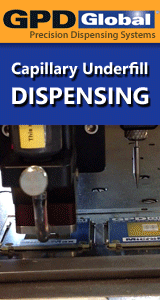Printed Circuit Board Assembly & PCB Design Forum
SMT electronics assembly manufacturing forum.
- SMTnet
- »
- Electronics Forum
- »
- AR/UR Coating Application
AR/UR Coating Application
Views: 3828
![]() I'm working on bringing up a new conformal coat process/work...
- Jan 31, 2018
by
dontfeedphils
I'm working on bringing up a new conformal coat process/work...
- Jan 31, 2018
by
dontfeedphils
![]()
![]()
![]() Hit wax dip of your edge connector.
HVLP spray your conform...
- Jan 31, 2018
by
sarason
Hit wax dip of your edge connector.
HVLP spray your conform...
- Jan 31, 2018
by
sarason
![]()
![]()
![]() Interesting, never heard of using wax as a coating mask. No...
- Feb 01, 2018
by
dontfeedphils
Interesting, never heard of using wax as a coating mask. No...
- Feb 01, 2018
by
dontfeedphils
![]()
![]()
![]() I'm not sure if your customer will allow it but consider sea...
- Feb 01, 2018
by
DeanM
I'm not sure if your customer will allow it but consider sea...
- Feb 01, 2018
by
DeanM
![]()
![]()
![]() We supply to defense primes, so there's not really any wiggl...
- Feb 01, 2018
by
dontfeedphils
We supply to defense primes, so there's not really any wiggl...
- Feb 01, 2018
by
dontfeedphils
![]()
![]()
![]() For anyone looking back on this post, I ended up figuring ou...
- Feb 06, 2018
by
dontfeedphils
For anyone looking back on this post, I ended up figuring ou...
- Feb 06, 2018
by
dontfeedphils
![]()
![]()
![]() Have you considered Teflon boots over your connectors? 1B31...
- Feb 09, 2018
by
Justin M
Have you considered Teflon boots over your connectors? 1B31...
- Feb 09, 2018
by
Justin M
![]()
![]()
![]() Yep, that's already in the works, but boots by themselves do...
- Feb 12, 2018
by
dontfeedphils
Yep, that's already in the works, but boots by themselves do...
- Feb 12, 2018
by
dontfeedphils
![]()
- SMTnet
- »
- Electronics Forum
- »
- AR/UR Coating Application







.gif)